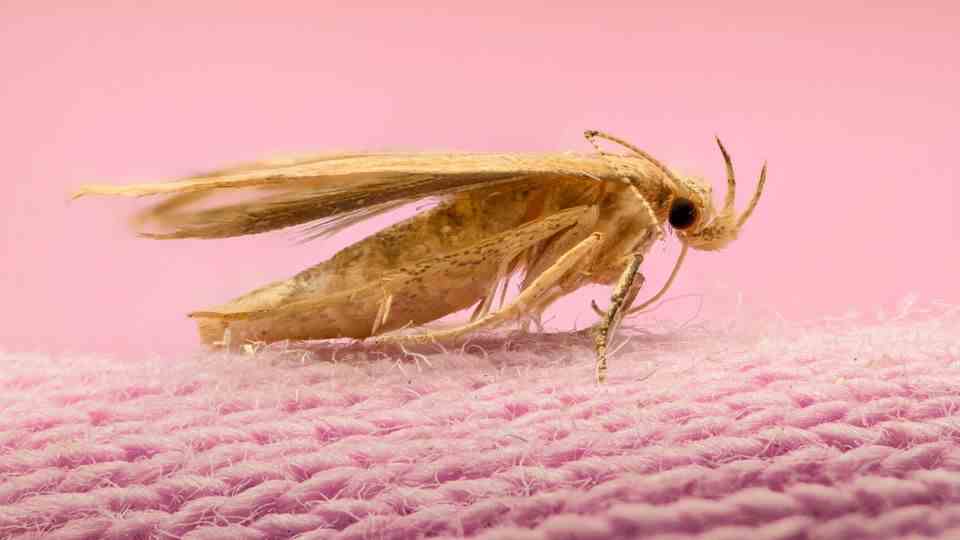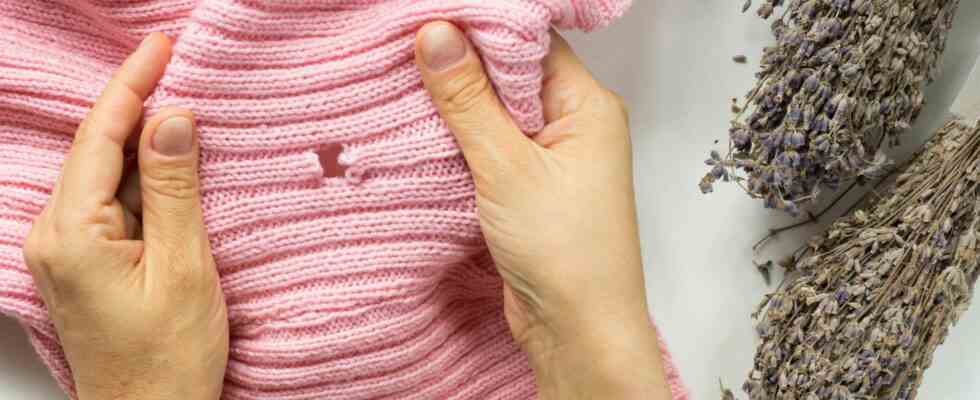textile eaters
Fight clothes moths: How to recognize the infestation – and take action against it
Circular moth holes in clothing are typical of an infestation
They like to eat textiles: clothes moths love wool, but they don’t stop at mixed fabrics either. What many do not know, however, is that it is not the moths that cause the damage, but their larvae.
Although the clothes moth is a butterfly, from a purely visual point of view it has nothing in common with its colorfully patterned relatives. On the contrary, the moth has yellowish or brown wings folded over its back like a shiny roof. An adult moth measures just six to nine millimeters, and its eggs are barely visible to the naked eye. However, their presence does not go unnoticed for long once they have infested a garment that is worn regularly. Because the larvae eat small, circular holes in the textiles. Then at the latest you can be sure that you have clothes moths in your home. Why the pests like to eat clothes and how to get rid of them is summarized below.
This is why clothes moths love textiles
As mentioned at the beginning, it is not the clothes moths that feed on the textiles, but their larvae – and the reason for this is as follows: They need keratin to grow. And that’s in animal hair, not just wool, but also leather and fur. Clothing that is made from purely plant-based and synthetic materials (including linen or cotton) therefore does not normally appear on their menu. They cannot be digested by the larvae. The same goes for paper and wood. In nature, the larvae are found in bird nests or breeding grounds of mammals and feed on the animal hair that is available there.
Since clothes moths react strongly to the smell of wool, fur and leather (or sweat), they also fly into numerous households. The attraction is so great that they squeeze through even the smallest crack to get to the textiles. In summer, of course, the pests have a particularly easy time when the windows are open: A female can lay 100 to 250 eggs, the larvae hatch two weeks later and pupate after three months – preferably in a warm, dry and dark place. Say in the closet, in holes or cracks. After about 60 days, sometimes it takes several months, they turn into a moth and then only live for 18 days.
How to get rid of clothes moths
The insidious thing about a clothes moth is that its flight season lasts from May to September – all summer, when most windows are open day and night. In addition, four generations can follow in one year from just one female moth. That’s a lot of eggs and hungry larvae. If you have found a possible infestation on your textiles, you can fight the clothes moths with the following tools and household remedies:
Classic trap
non-toxic sticky traps contain so-called pheromones, i.e. sex attractants for male clothes moths. The insects stick to the glue surface and die there, so they can no longer fertilize female moths. The trap has an effective time of up to three months and can be set up, hung up or glued on. Best in a dark, draught-free place like the wardrobe at a height of two meters. Keep the windows in the room closed to avoid attracting additional moths from outside.
natural defence
Include natural moth repellent lavender sachet. They are simply placed in the cupboard and spread a pleasant scent that the butterflies don’t like. The same applies to things left in their natural state cedar – here there are special rings that you can attach to the hangers. The wood not only repels clothes moths, but also absorbs odors and moisture. By regularly sanding the rings, the wood retains its effect for several months.
biological control
parasitic wasps are natural enemies of clothes moths – and can be used like a kind of biological weapon: the insects are only a few millimeters in size and target the moth’s eggs. It is best to place the delivered wasp eggs in the form of small cards next to or directly on clothing so that the animals reach their destination as quickly as possible. If there are no more clothes moths, the parasitic wasps disappear automatically. Repeat the process three times.
heat and cold
Clothes moths like it dry and warm, but cannot tolerate heat – or cold. For this reason you should heat all textiles that may be infested to 60 degreeswash. However, you can store delicate items of clothing made of wool, leather or silk in a plastic bag freezerstore for several days. Or you can take a small piece of leftover wool, put it in a box, cut a hole in it and wash the wool hot after a week to kill the laid eggs.

This is how a clothes moth (Tineola bisselliella) looks extremely enlarged
© Constantin Cornel / Getty Images
Preventing clothes moths: This is how it works
You can take preventive measures to prevent clothes moths from nesting in your cupboards and damaging your textiles in the first place. This not only applies to your clothes, but also to your carpets and upholstered furniture, which the pests won’t stop at (if they contain wool, leather or fur). You should avoid these mistakes:
- Don’t keep worn clothes in the closet as clothes moths are also attracted to sweat, hair and dander.
- Moths prefer dark and dry places, so rotate your clothes regularly and avoid hanging them too close together.
- Regularly vacuum carpets and upholstered furniture containing materials of animal origin. Hair and dander also collect here.
- Air your cupboards and shelves where textiles are stored regularly – and wipe them with lavender or vinegar water.
- Use linen or cotton sacks to store expensive clothes made of silk or leather, for example. Clothes moths cannot digest these materials.
- If you want to store or store clothes in boxes, wrap the textiles in newspaper beforehand. For reasons that have not yet been explained, the moths avoid printing ink.
- The longer clothing is stored, the less disturbed clothes moths can multiply in it. It is all the more important to check the textiles regularly for infestation.
You might also be interested in:
This article contains so-called affiliate links. Further information are available here.

